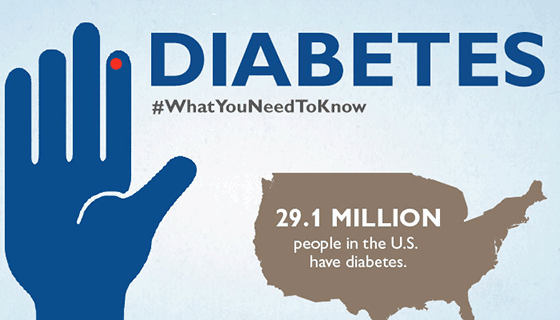Prediabetes
Featured Expert
Before developing type 2 diabetes, people have prediabetes. Having prediabetes means your blood glucose (sugar) levels are higher than normal, but not yet at the point that defines diabetes. However, having prediabetes means you are already at increased risk for damage to your heart, kidneys and nerves.
Nisa Maruthur, M.D., M.H.S., Associate Professor of Medicine, Epidemiology and Nursing at Johns Hopkins Medicine, provides some insights.
What You Need to Know
- Having prediabetes means you are at risk for developing type 2 diabetes.
- Risk factors for prediabetes and diabetes include obesity; a sedentary lifestyle; a parent, brother, or sister with type 2 diabetes and diabetes during pregnancy.
- Prediabetes typically has no symptoms and is usually diagnosed with a blood test.
- Having prediabetes does not mean you are destined to develop diabetes. Adopting a healthier lifestyle can reduce your risk of type 2 diabetes and even reverse prediabetes.
What is prediabetes?
“Prediabetes is defined as having blood glucose (sugar) levels that are higher than normal, but not yet at the point that defines diabetes,” Maruthur explains.
“For people with prediabetes, blood sugar levels can increase slowly over time. Your health care provider may refer to prediabetes as impaired glucose tolerance (IGT) or impaired fasting glucose, or IFG.”
She continues, “When you eat, the digestive process breaks down the food into a simple sugar called glucose, which enters your bloodstream. Glucose is fuel for your body’s cells and organs. A hormone called insulin helps deliver the glucose to the cells in your body. Insulin is produced in the pancreas, a gland behind the stomach.
“Prediabetes and diabetes may develop if the pancreas does not make enough insulin to deliver glucose to the cells and too much glucose builds up in the blood. Another cause is when the cells stop allowing the insulin to deliver the sugar ― a condition called insulin resistance.”
Prediabetes Symptoms
According to Maruthur, most people with prediabetes do not know they have it because there are usually no symptoms. “Some people with prediabetes may already have nerve damage, which can cause tingling or numbness in the feet and hands,” she notes.
If you are at risk for prediabetes, your doctor may test your blood for sugar levels, or a blood sugar test might be part of your regular check-up.
What causes prediabetes?
Maruthur says it is not always clear why some people develop prediabetes and others do not. “We know that body weight, diet and physical activity play a role,” she says. “There may be a genetic link, also, since people with prediabetes often have family members with type 2 diabetes.”
Risk Factors for Prediabetes
- Being older than 45 (though diabetes and prediabetes can develop in children)
- Having a parent, brother or sister with type 2 diabetes
- Overweight or obesity
- Not being physically active
- Having African, Hispanic, Asian, Pacific Island or Native American heritage
- A history of gestational diabetes, diabetes that occurs when you are pregnant
- Giving birth to a very large baby (9 lbs. or more)
- Polycystic ovary syndrome (PCOS)
Prediabetes Diagnosis
To diagnose prediabetes, your health care practitioner may recommend one or more of the following tests.
“For a diagnosis of diabetes, your health care provider will usually confirm the first test with a second test,” Maruthur says.
A1C Test
This test looks at a component of your blood called hemoglobin. Hemoglobin is a protein that binds with sugar, especially when sugar levels are high. High levels of blood cells with sugar stuck to their hemoglobin (“hemoglobin A1c”) can indicate prediabetes or diabetes.
- Normal: less than 5.7%
- Prediabetes: 5.7%–6.4%
- Diabetes: 6.5% or higher
Fasting Plasma Glucose Test
Typically, you take this test first thing in the morning since it measures blood sugar when you have not had anything to eat or drink (other than water) for eight hours.
- Normal: less than 100 milligrams per deciliter (mg/dl)
- Prediabetes: 100 mg/dl–125 mg/dl
- Diabetes: 126 mg/dl or higher
Oral Glucose Tolerance Test
This test measures how your body reacts two hours after you have been given a special sugary drink.
- Normal: less than 140 mg/dl
- Prediabetes: 140 mg/dl–199 mg/dl
- Diabetes: 200 mg/dl or higher
Random (Casual) Plasma Glucose Test
If you are showing symptoms of diabetes, this blood test can be given any time, and a blood sugar value of 200 mg/dl or higher would indicate diabetes. “Symptoms of diabetes can include excessive urination or thirst, weight loss when you’re not trying, blurry vision, numbness or tingling of your hands or feet, and frequent infections,” Maruthur says.
Prediabetes Treatment
Healthier lifestyle: “A healthy lifestyle can slow, stop and even reverse the progress of prediabetes,” she explains. “This is important to realize since diabetes is serious and associated with health problems and complications that can affect your quality of life and even endanger your health.
“With that in mind, your health care practitioner may consider referring you to a diabetes prevention program.”
Medications: In addition to recommending a healthier lifestyle, your doctor may give you medications to lower your blood sugar when you have prediabetes.
Self-care: Successfully managing prediabetes is possible when you can do the following:
- Eat a healthier diet.
- Exercise regularly.
- Lose some weight. A relatively small amount of weight loss ― 5% to 10% of your body weight ― can help lower your blood sugar.
- Quit smoking.
- Manage stress.
The Prediabetes Diet

If your doctor says your bloodwork reveals prediabetes, you’re bound to have questions about what’s best to eat. Tara Seymour, an advanced practice clinical dietitian and diabetes educator at Johns Hopkins, provides guidance on how a healthy diet and lifestyle can control — and even help reverse — prediabetes.
A National Program for Reversing Prediabetes
The National Diabetes Prevention Program works to make it easier for people with prediabetes to participate in affordable, high-quality lifestyle change programs to reduce their risk of type 2 diabetes and improve their overall health.
Its CDC-recognized lifestyle change program is an evidence-based approach that focuses on healthy eating and physical activity. People with prediabetes who take part in a structured lifestyle change protocol can cut their risk of developing type 2 diabetes by 58% (71% for people over 60 years old). Learn about the Diabetes Prevention and Education Program at Johns Hopkins.
If I have prediabetes, will I get diabetes?
Not necessarily. Without intervention, prediabetes is likely to develop into diabetes, but lifestyle changes can make a difference and even reverse prediabetes.
Being diagnosed with prediabetes can be concerning but can also give you an opportunity to take steps and get your blood sugar under control before diabetes takes hold.
Maruthur says, “The good news is that making even small lifestyle changes can have an impact on your diabetes risk. By taking control, you can stop the progression of prediabetes and increase your chances of living a healthier, happier and longer life.”







